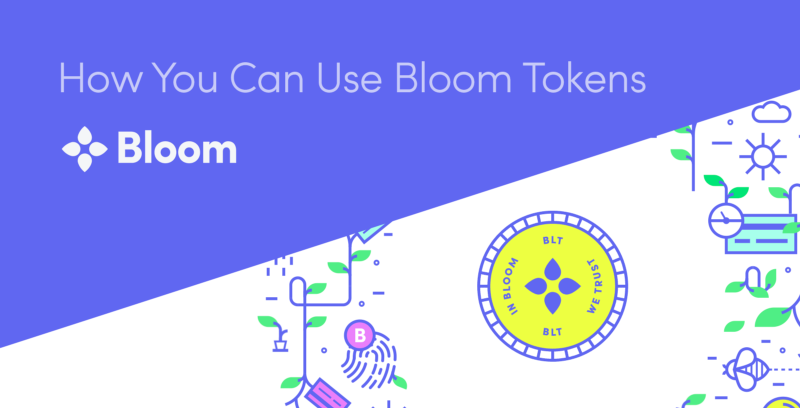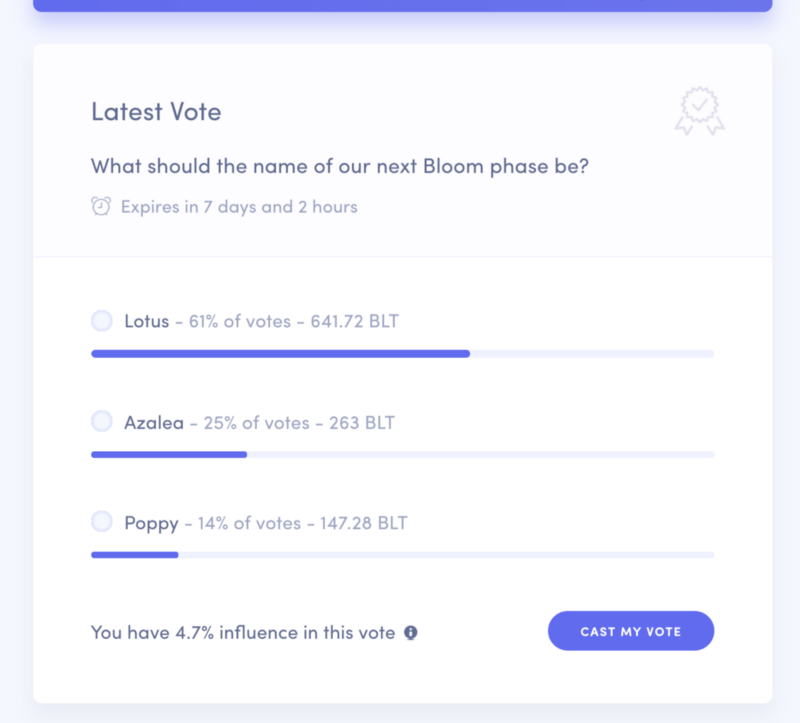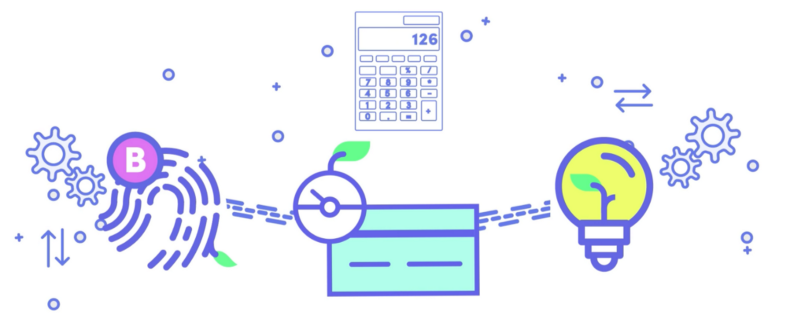How You Can Use Bloom Tokens

As a BLT token holder, you have immediate access to all the Phase 1 features of Bloom the moment the token sale completes and the tokens become transferrable on January 1st.
Specifically, this includes the BloomID creation, the peer invitation system and most importantly, the protocol voting portal.
The Bloom voting portal gives you immediate influence over a selection of protocol level decisions. By staking your BLT to votes, you have influence over key decisions that the network must make. BloomID registration, invitations and voting will begin on January 1st.

BLT functions both as a currency within the Bloom Protocol and as a resource on a distributed computing platform. BLT is used not only as a means of exchange or payment on the Bloom Protocol but also as a means to account for, judge and verify community participation. In the Bloom Protocol, BLT is the native fuel that facilitates interactions on the Bloom Ecosystem.
How does this all fit together?
Bloom is a protocol for identity verification, credit scoring and risk assessment. From developing lending applications, to using BloomID to prevent fraud, developers, lenders, and individuals may use BLT in a number of ways.
BLT is needed to generate BloomID’s, verify identifying traits, update information to the network, and check BloomScores. The BLT fees can be paid directly by a user who wishes to proactively have access to their BloomID and build their profile ahead of time. Alternatively, the BLT can be paid by a business (an application or lender wishing to ensure their users are verified through the Bloom network).
Lenders can use BLT to check BloomScores, verify identities, and gain credit information about their borrowers.
All network participants can also use BLT to vote on network decisions.
The use cases vary and this post explains the different groups that have a need for BLT and exactly how it is used in the protocol.
In the first phase of Bloom:
Upon the completion of the token sale on January 1st, the BLT will have immediate use in the network.
BLT will allow you to establish the first version of your BloomID and invite others to the platform.
More importantly, BLT will serve a critical early role for protocol voting. Bloom is a community-driven project and BLT token holders have a voice over key decisions the network must make. Right from the start, BLT holders will be able to stake their tokens to express their choice over these early decisions.
BLT can be used by a number of different groups:
Many lenders and businesses are already building applications on top of Bloom. BLT is needed for these components of the network which will be released over time as we expand the phases. Many of the use cases below will become live as development continues over the next phases of the project.
- Lending businesses: Lending businesses rely on credit scoring to make decisions around loan issuance and interest rates. Bloom is a natural fit for these businesses. Lending businesses can use BLT to check someone’s credit history, verify their identity, and participate in the development and updates of the network.
- Non-Lending based Applications: Just like traditional credit scores, Bloom offers benefits to non lending based applications. Examples include: reducing signup fraud, creating a decentralized reputation, allowing for a global identify and assessing fraud risk. These businesses can pay the BLT needed to generate a BloomID on behalf of their users to reduce friction and increase security. Alternatively, they may simply use BLT to verify certain identifying traits after signup.
- Data Providers and Identity Attesters: Data providers and identity attesters are critical to ensure that the network has sufficient information to verify someone’s identity. They are also needed to pull in the needed credit data to generate the BloomScore. These businesses can earn BLT by participating in the attestation of a user.
- Everyday People: With BloomID, you will be able to easily apply for loans, see which information is included in your credit profile, and take an active role in improving your credit worthiness through organizational and peer-to-peer staking. You may wish to own BLT in order to pay the fees necessary to generate your BloomID, and to increase your credit worthiness by paying the fees needed for your ID to accrue attestations and a thick credit profile. As a BLT token holder, you may also vote on key aspects of the Bloom protocol, ensuring that the network stays fair and balanced.
The following sections expand on these areas.
For Non-Lending based Applications:

Credit scores have a number of uses outside of lending. As a non lending based application, you might want to use BLT to verify identity information. You may also want to require that your users have a BloomID, in which case you may want to use BLT to pay for the fees associated with your users creating a BloomID.
Here are some of the use cases:
- Reduce Duplicate Accounts: A decentralized protocol might require that all users have a BloomID before being allowed to join a Slack community, an online forum, or even social networks. In order to ensure that your users are legitimate, you may want to generate a BloomID during their signup process. To reduce friction, you can pay for their signup fees in BLT so that your user does not need to hold BLT or have an existing BloomID.
- Reduce signup fraud by verifying identity elements connected to a BloomID: The creation of a BloomID must be tied to a real world identity. This means that if you wish to lower the rate of fraud or mitigate against fake ID’s, you can verify your users signup information using BLT. Once you collect signup information from your user, BLT is needed to pay for the data attesters to check that this information matches the verified information as part of a BloomID.
- Reviews & Reputation: Many marketplaces, e-commerce sites, vendors, sharing economy businesses, and peer to peer services rely on reputation. You may want to associate the reputation and reviews of a user with that users BloomID to ensure they cannot start over a new reputation in your platform. Associating this reputation with their BloomID will require BLT.
- On-Time Payment Checking: A number of businesses that do not issue loans will still want to review credit history to ensure that their users will pay on-time. (Landlords, SaaS businesses, etc) An application can either require users to have a BloomID, or contribute BLT towards the creation of a users BloomID. Once the BloomID is generated, that user can authorize the release of their payment history to the app.
Related Reading: Decentralized Reputation: How Gems is using Bloom Protocol to Mitigate Sybil Attacks
For Lenders and Developers building Lending based Applications:

FICO provides credit scoring for more than 90% of top US lenders. FICO’s credit scoring system leaves over 26 million Americans “credit invisible” and an additional 19 million unscorable. As a lender, these are valuable customers you are missing out on.
Additionally, many current credit scores do not include key data points, such as utility bill payment information, cell phone payment information, or fraud risk scores.
Include BloomScore in your lending decisions:
- Check the BloomScore and metrics of your borrower: BloomScore includes 1) A reliability score (a metric gauging a user’s individual credit repayment history success) 2) A Peer score (a metric to determine the average reliability score of the peers of the user) 3) Number of loans taken out in the past on the Bloom network 4) Past identity attestations performed. These are useful pieces of information to know prior to extending a loan. Checking a BloomScore requires BLT.
- Verify your borrowers identity: In both decentralized and centralized environments, verification of an identity is critical to prevent fraud and ensure that you are lending to the correct individual. In a decentralized environment, it’s incredibly difficult to mitigate fraud without Bloom. BLT can be used to verify a borrowers identity to reduce the risk of fraud and Sybil attacks.
- Pay the BLT fees needed for a borrower to add peer-to-peer stakes to their ID: Just as references and background checks reduce the risk of a loan, so do peer-to-peer stakes. Not only does this process facilitate access to credit for new users, but it increases permanence in credit scoring and ensuring appropriate weighting of long-term and short-term spending and payment habits, e.g. by avoiding users creating new accounts to reset their score. And ID with peer-to-peer stakes is more resilient to fraud through the Bloom network
- Allow borrowers with a BloomID to quickly apply for loans: If a user already has a BloomID, you may choose to let that user “quick apply” for a loan. In this method, you would only need BLT to verify their identifying traits during the final loan application.
For Data Providers and Identity Attesters:

The Bloom protocol relies on established nodes to “attest” to a user’s identity information. The protocol also relies on trusted parties to submit data about a users creditworthiness to a BloomID. In both of these instances, parties with the relevant information are able to earn BLT for participating in the network.
- Verify Identity Traits: Each identity attestation requires payment of BLT. As an identity verifier, you can apply to earn BLT by verifying identifying traits of users applying for Bloom ID’s.
- Publish information back to the network: By publishing all historical identity attestations on the blockchain, organizations can help take part in building a reusable identity that builds up trust over time rather than having to be re-evaluated for every transaction with a new lender. This can not only save money across the network of lenders, but it can also help significantly reduce on-boarding time by reducing duplicate work by anti-fraud and compliance teams across lending organizations.
Related Reading: Bloom Partnership: TypingID
For Everyday People:
- Vote on Protocol Level Decisions: Bloom is a community driven project. BLT voting allows us to ensure that the network is free from excessive influence from any one party and stays fair and balanced.
- Generate a BloomID: For users who want to proactively take control of their credit, BLT is needed to establish a BloomID.
- Check your BloomScore: It’s important to stay on top of your credit profile. BLT can be used to get an updated snapshot of your score.
- Apply for loans: Over time, the Bloom application will include a list of lenders accepting BloomID’s as part of applications.
- Score proposals: Loans impact everyone. BLT based voting allows us to root out bad actors and keep the system stable and provide influence to those who are contributing most to the network. This is also the primary mechanism of defining future changes to the BloomScore.
Learn More:
- Join our Slack community
- Follow us on Twitter
- Follow our Updates
- Join the newsletter

